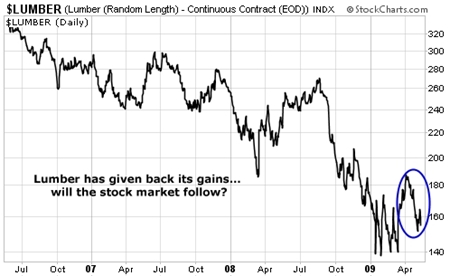Why the lumber market holds the key for investors
Can you really predict the stockmarket by watching the price of timber? Tom Dyson explains why the lumber market could be a useful indicator for making investment decisions.
To predict the stock market, I watch lumber...
To store lumber, you need a large climate-controlled warehouse with a railroad spur. Even then, it could still spoil within six months, destroying your entire investment.
Because lumber loses its value quickly and it's expensive to store, the investment public at large does not participate in the lumber market. The costs are too high...
MoneyWeek
Subscribe to MoneyWeek today and get your first six magazine issues absolutely FREE

Sign up to Money Morning
Don't miss the latest investment and personal finances news, market analysis, plus money-saving tips with our free twice-daily newsletter
Don't miss the latest investment and personal finances news, market analysis, plus money-saving tips with our free twice-daily newsletter
The mills use "just-in-time" manufacturing principles to keep inventories to the bare minimum. By producing only what they can sell immediately, they avoid wastage. Lumber customers do the same thing. They only buy what they need that week.
There is a lumber exchange in Chicago where you can trade lumber futures. It's a "professionals only" industrial matchmaking service. If you're a homebuilder and you need lumber for a current construction project, the lumber exchange works fine for you. But if you're an investor looking to hold lumber for a year or more, you'll get ripped off.
First, you'll pay huge storage costs. The market builds these costs into the futures price. Second, there's almost zero trading volume once you get beyond the next three months, so you'll pay a massive premium for illiquidity.
For example, right now, if you want to buy lumber into the future say a contract that expires one year from now you'll have to pay a 38% premium over the price of lumber delivered next week.
These costs keep the riff-raff out of the market. This is why I love to watch lumber. The price of lumber is set entirely by commercial money responding to real business conditions. There's no public speculation to muddy the water and generate confusing signals.
Take the 2008 credit crisis as an example. The lumber price was the first to signal a bear market was coming. It peaked in May 2004. The Bloomberg Homebuilders Index peaked in July 2005. The Case-Shiller U.S. home price index peaked in July 2006. The credit crunch started in February 2007, when New Century Financial collapsed. And finally, the S&P 500 peaked in October 2007.
Here's a chart of lumber going back three years. As you can see, lumber bounced like everything else earlier this year, but has not been able to hold its gains.

I take this as a message from the homebuilders and the giant logging companies that the real estate market is getting worse again. And if that's the case, it might be time for stocks to take a breather, too...
This article was written by Tom Dyson, co-editor of the free daily investment newsletter DailyWealth
Get the latest financial news, insights and expert analysis from our award-winning MoneyWeek team, to help you understand what really matters when it comes to your finances.
MoneyWeek is written by a team of experienced and award-winning journalists, plus expert columnists. As well as daily digital news and features, MoneyWeek also publishes a weekly magazine, covering investing and personal finance. From share tips, pensions, gold to practical investment tips - we provide a round-up to help you make money and keep it.
-
 Rightmove: Asking prices set to rise 2% in 2026 after post-Budget market rebound
Rightmove: Asking prices set to rise 2% in 2026 after post-Budget market reboundBuyers and sellers who held off in anticipation of the Budget will come back to the market and contribute to asking prices increasing next year, according to Rightmove
-
 Coreweave is on borrowed time
Coreweave is on borrowed timeAI infrastructure firm Coreweave is heading for trouble and is absurdly pricey, says Matthew Partridge

